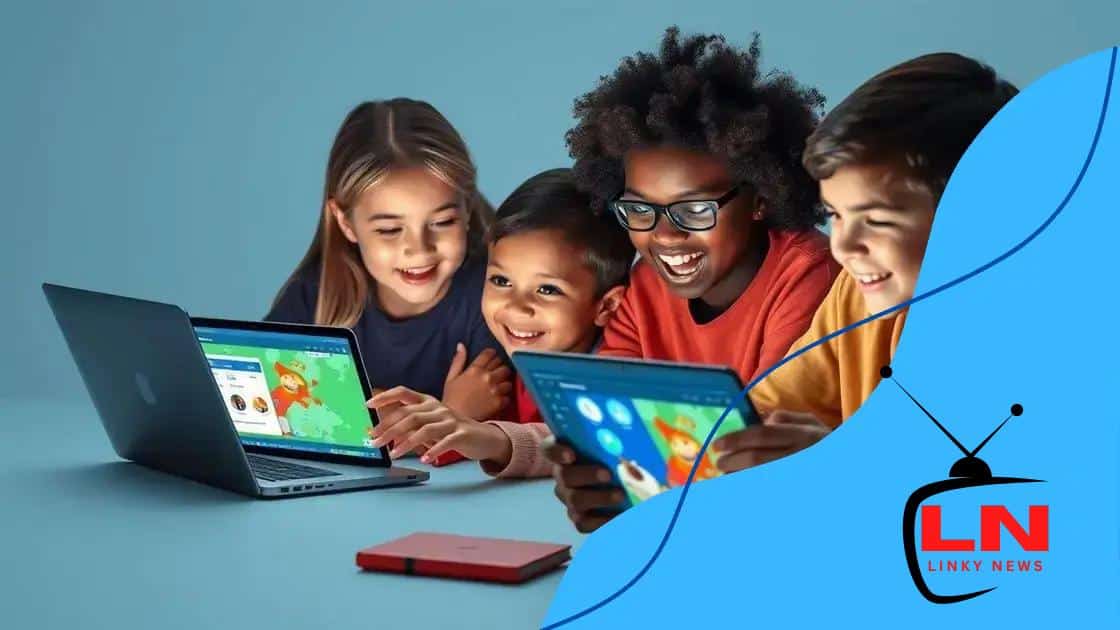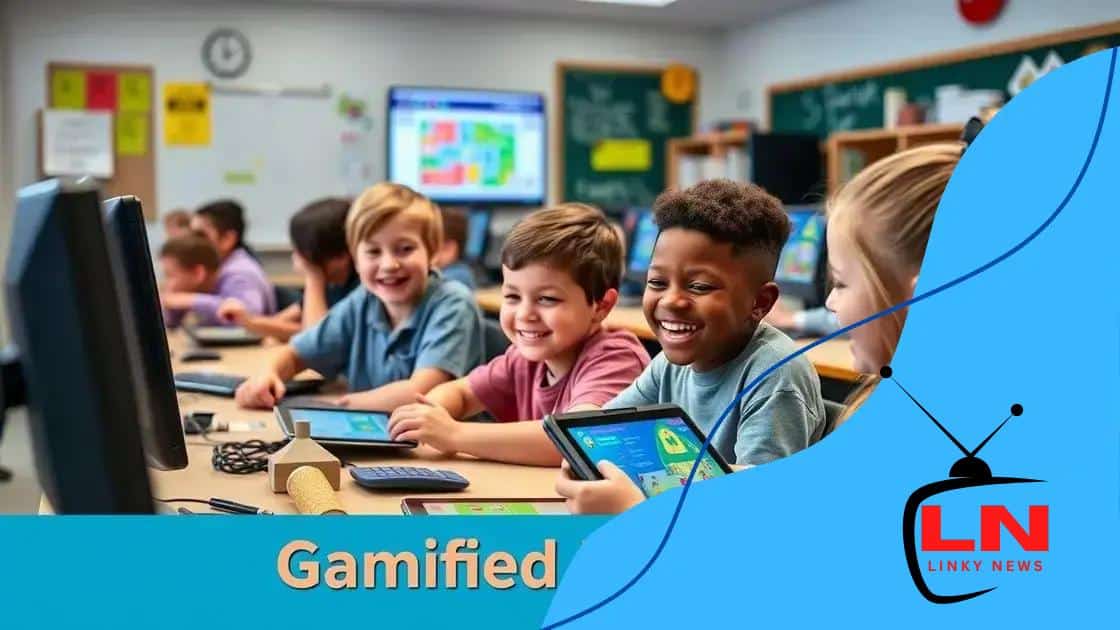Gamified education platforms that boost learning engagement

Gamified education platforms use game mechanics to enhance student engagement, personalization, and learning outcomes, making education more interactive and effective.
Gamified education platforms are changing the way we think about learning. By incorporating game elements, these platforms make education more engaging and enjoyable. Curious about how they work? Let’s dive in!
Understanding gamified education platforms
Understanding gamified education platforms is essential in today’s interactive learning environment. These platforms blend educational content with game mechanics to enhance engagement and motivation among learners.
What Are Gamified Education Platforms?
Gamified education platforms use game design elements to encourage participation and improve the learning experience. By integrating elements like points, badges, and leaderboards, they transform traditional learning into a fun and interactive activity.
Key Features of Gamified Platforms
Several features make these platforms effective:
- Engaging Content: Interactive activities that stimulate curiosity.
- Instant Feedback: Learners receive immediate responses to their actions.
- Progress Tracking: Clear visuals of learner advancement.
- Social Interaction: Opportunities for collaboration and competition among peers.
These characteristics not only make learning enjoyable but also help students retain information better. Gamification encourages users to set their own goals and achieve them at their own pace.
Benefits of Gamified Learning
Implementing gamified education platforms can lead to numerous benefits. Firstly, they boost motivation, as learners are driven to earn rewards. Secondly, they foster deeper understanding through playful learning. Lastly, these platforms can cater to various learning styles, ensuring that all students find a method that works for them.
Overall, gamified education is an evolving approach to learning that merges engagement with educational goals, making the learning process exciting and effective.
Key features of effective gamified platforms
Key features of effective gamified platforms play a crucial role in enhancing the learning experience. By incorporating these elements, educators can create a more engaging and interactive environment for students.
Interactive Elements
One of the standout features is the incorporation of interactive elements. These elements, such as quizzes and challenges, keep learners involved. They make education feel less like a chore and more like a game, encouraging participation.
Progress Tracking Mechanics
Another important feature is tracking progress. Learners appreciate seeing their improvements over time. Gamified platforms often include visual dashboards that display completed lessons and points earned. This immediate feedback motivates learners to continue their journey.
- Instant Feedback: Users receive quick updates on their performance.
- Goal Setting: Students can set personal learning objectives.
- Rewards and Badges: Earning achievements boosts motivation.
- Leaderboards: Adding a competitive aspect encourages engagement.
These features not only make learning enjoyable but also help students feel a sense of accomplishment as they progress. When students see their names climbing the leaderboard or receive badges for completing tasks, their motivation grows.
Customization Options
Customization is another compelling feature of gamified education platforms. Educators can tailor the content according to their students’ needs. Customizable avatars and learning paths can make the experience more personal, allowing learners to connect better with the material.
This element of choice can lead to increased investment in their education, as learners feel they have a stake in their own learning process. Overall, these features work together to create a dynamic and engaging learning environment.
Benefits of gamified learning for students

Understanding the benefits of gamified learning for students is essential in modern education. This approach transforms traditional learning methods into engaging experiences.
Enhanced Motivation
One primary benefit is enhanced motivation. When students play games, they often feel excited and eager to learn. This excitement translates into their studies, making them more likely to participate in class activities.
Improved Retention
Another significant advantage is improved retention of information. Gamification encourages students to revisit concepts repeatedly and in fun ways. This repetition helps cement knowledge effectively.
- Instant Rewards: Rewards like points or badges give immediate satisfaction.
- Interactive Learning: Active participation boosts engagement.
- Social Connections: Working in teams helps build friendships and collaboration skills.
- Self-Paced Learning: Students can learn at a pace that suits them best.
These factors create a positive feedback loop where increased motivation leads to better learning outcomes. As students see their progress while playing, they become more invested in their education.
Building Critical Skills
Gamified learning also helps in building critical skills. As students face challenges and solve problems, they develop important skills like critical thinking and teamwork. These experiences prepare them for real-world situations.
Additionally, the game-like environment allows students to experiment without the fear of failure. They can try different strategies and learn from mistakes, making education a safer place for exploration.
Real-world examples of gamified education
Real-world examples of gamified education showcase how engaging game mechanics can enhance learning experiences in various environments. These platforms illustrate the effectiveness of gamification in real classroom settings.
Kahoot!
One popular example is Kahoot!, an interactive quiz platform used by educators around the globe. Teachers create quizzes that students answer in real-time using their devices. This game-like atmosphere fosters competition and collaboration. Students can see their scores instantly, which boosts their motivation to learn.
Classcraft
Another great example is Classcraft, where education meets role-playing games (RPGs). Students create avatars and embark on learning adventures tied to their curriculum. They earn experience points and rewards by participating in class, completing assignments, and collaborating with peers. This approach transforms classroom behavior into an integral part of the learning process.
- Engagement: Students are more engaged when learning feels like a game.
- Teamwork: Platforms like Classcraft encourage teamwork and social skills.
- Custom Challenges: Teachers can customize challenges to suit their class needs.
- Behavior Tracking: Students are motivated to maintain good behavior to earn rewards.
These examples demonstrate that gamified education not only enhances knowledge retention but also helps develop soft skills such as teamwork, communication, and problem-solving.
Duolingo
Additionally, Duolingo utilizes gamification to teach languages. Users complete lessons in a game-like format, earning points and leveling up through consistent practice. The app’s friendly competition and instant feedback keep learners motivated, making language acquisition enjoyable.
These real-world examples highlight how gamified education can significantly improve student engagement and learning outcomes. They show that integrating game elements into education can captivate students and foster a love for learning.
Future trends in gamified education
Future trends in gamified education continue to evolve as technology advances. These trends promise to make the learning experience even more engaging and effective for students.
Increased Use of Artificial Intelligence
One major trend is the increased use of artificial intelligence (AI). AI can personalize the learning experience for each student based on their skill level and learning pace. This means tailored content that keeps students motivated and challenged while addressing their specific needs.
Virtual and Augmented Reality
Another exciting development is the integration of virtual and augmented reality (VR and AR). These technologies provide immersive learning experiences, allowing students to explore complex concepts in a visual and interactive manner. For example, VR can transport students to historical places or scientific environments, making learning feel more real.
- Interactive Simulations: Students can engage in realistic scenarios that enhance understanding.
- Gamified Assessments: Testing skills through games rather than traditional exams.
- Collaboration Tools: Platforms that enable teamwork while playing educational games.
- Data Analytics: Insights into learning patterns to improve student outcomes.
These advancements will help educators understand how students learn best and adapt their teaching strategies accordingly. As gamified education grows, student interactions will become more enjoyable and effective.
Global Learning Communities
Another trend is the rise of global learning communities. With the help of technology, students from different parts of the world can collaborate and play educational games together. This exchange of ideas and cultures enriches the learning experience and builds global awareness.
As we look ahead, the future of gamified education appears bright. By embracing these trends, schools can create interactive, supportive, and effective learning environments.
FAQ – Frequently Asked Questions about Gamified Education
What is gamified education?
Gamified education incorporates game elements into learning to enhance student engagement and motivation.
How does gamification benefit students?
It increases motivation, improves retention of information, and encourages collaboration among peers.
What technologies are used in gamified learning?
Technologies like artificial intelligence and virtual reality are used to create personalized and immersive learning experiences.
Can gamified education adapt to different learning styles?
Yes, gamified education often offers multiple pathways to learning, catering to various preferences and skill levels.





